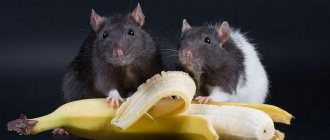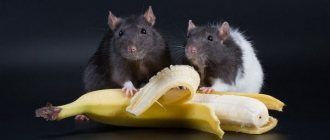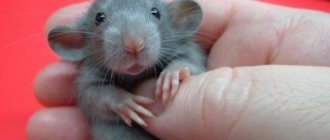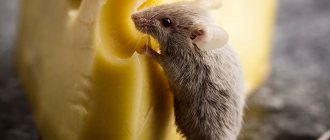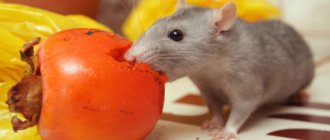- home
- Rat
- Nutrition
08/06/2019 Rodent breeders strive to diversify the diet of their charges in every possible way and add treats and treats to the diet. But can everything be used as a treat for your pet? This article is designed to help pet owners answer one of these questions and tell them whether rats can have eggs or not.
Peculiarities
The egg yolk makes up about 48% of the egg's weight, about 50% is the white.
A small part of the mass is the shell. The entire burden of forming calories falls on the yolk; it is 3 times more caloric than protein. Therefore, when preparing diets for weight loss or fitness, they try to exclude the yolk from the diet as much as possible. There are discussions in the consumer community about the increase in cholesterol in the body when eating eggs. This is possible if you significantly exceed the daily dose. It should be remembered that the yolk, in addition to conditionally harmful cholesterol (for men, it serves as the basis for the creation of testosterone), contains lecithin, which is an anti-sclerotic factor. Its content in the yolk significantly exceeds the amount of cholesterol. Therefore, the risk of a sharp jump in blood cholesterol levels is compensated by lecithin.
What treats can be given from the diet?
To pamper your pet, you don’t have to run to the nearest pet store. Most of rats' favorite treats can be found in the normal human diet. Among the favorite dishes of rodents:
- Food of animal origin - lean meat, fish, squid, shrimp, meatballs . Meat dishes must be served boiled. When cooking, it is prohibited to use salt or any seasonings. It is recommended to give protein treats to rats once a week.
- Food of plant origin - vegetables, berries and fruits grown in your own garden can be offered to rodents 3-5 grams daily. Store-bought foods can be full of nitrates and other harmful substances, so such treats are allowed to be given to the rat once every 4-5 days. Favorite juicy foods: apple, banana, peach, raspberry, strawberry.
- Puree for baby food . Any options are suitable: meat, fruit, vegetable. “Ready” dishes are also allowed, for example, beef with vegetables or hake with vegetable stew. The norm is once every 7-10 days. When feeding baby puree to rodents, the storage conditions should be observed - an opened jar can be stored in the refrigerator for no longer than 24 hours.
- Seeds and nuts . Such delicacies are very high in calories, so it is allowed to treat rats with them no more than 2 times a week. In this case, you need to give rodents nuts and seeds in their unprocessed form - not fried, not salty, not sweet, and preferably unpeeled. The norm for one feeding is 1 nut or 5-6 seeds.
- Flour dishes: biscuits, homemade crackers, crackers . Such delicacies should contain a small amount of salt and sugar and be slightly dried. If these conditions are met, you can offer the rat 1 cm² bread treats every 3-4 days.
- Dark chocolate with a percentage of cocoa beans of 75-80%. It is allowed to be given daily, only subject to one condition - the size of the piece should be no more than 5 by 5 mm.
- Dairy products . This category includes kefir, cottage cheese, fermented baked milk, homemade yogurt, and yogurt. The main condition is that the dish should have low fat content, within 1-5%. Once every 2 weeks you can pamper your rat with sour cream, but in minimal quantities - 2-3 grams.
Boiled eggs on rats' menu: benefit or harm?
Domestic rats enjoy eating boiled eggs. Therefore, some owners treat their little pets to this delicacy almost every day, believing that it is good for their body and gives their fur shine and a well-groomed appearance.
This product is truly a healthy and nutritious treat for cute animals, but if used incorrectly, it can be harmful to the health of the animal.
You can avoid this by adhering to several rules:
- Rodents may be allergic to this product. Therefore, when offering eggs to rats for the first time, it is necessary to observe whether the animal has an allergic reaction (itching, redness of the skin);
- adult pets are fed a boiled egg no more than once a week;
- small rats can be given such a treat once every three to four days;
- Rats prefer boiled egg yolks to whites. But the animal may choke on the yolk and before feeding it is advisable to dilute it with a small amount of water or milk;
- It is not recommended to give fried eggs to pets, as they are prepared with the addition of sunflower or vegetable oil, which is harmful to the liver of rodents;
- We should also not forget that these foods are quite high in calories and their excessive consumption can lead to the development of obesity in the animal.
Important: rodents should not be fed salty, hot or spiced foods, so you should not give them eggs from your table, for example, stuffed or covered in sauce.
Mechanical methods of struggle
Can rats steal eggs? Yes, they can and do come up with clever ways. The owner of the chicken coop can suffer significant damage, so it is imperative to fight them. For this purpose, mechanical traps are used, inside which bait is placed.
They are installed in places inaccessible to hens and chicks so that they are not caught instead of rodents. And cunning rats can bypass them. Glue traps are often used, which are ineffective for strong adults that can tear their paws off the smeared surface. Another drawback: the rodent remains alive and must be destroyed or released by someone.
Useful properties, composition
Almost all types of eggs can be eaten, but chicken eggs are the most popular and in demand due to their low calorie content.
Daily use 1 pc. A boiled egg will allow you to get the necessary vitamins, macro- and microelements.
Eating a product can be beneficial or harmful, which largely depends on the person’s health status and the number of eggs eaten. Nutritionists and doctors do not recommend eating more than 2 eggs per day.
The egg contains many vitamins A and B, biotin, choline and other elements.
The benefits of eating eggs are associated with their beneficial effects on the functioning of the whole body:
- the state of the nervous system is normalized;
- oncological diseases are prevented;
- has a beneficial effect on mental development by improving the nutrition of brain cells;
- liver performance is normalized;
- the balance of hormones in men is stabilized;
- toning of the walls of blood vessels occurs;
- the body's resistance increases, immunity increases;
- 1 egg with a low calorie content, which is boiled, can reduce the feeling of hunger due to the selenium content in it.
The egg contains many vitamins A and B, biotin, choline and other elements.
Possible harm from consuming the product is associated with the following points:
- significant cholesterol content;
- possibility of salmonella infection;
- in case of diabetes mellitus, consuming the product doubles the risk of heart attack;
- danger of allergic reactions.
Due to the potential danger of allergic reactions in children, there are a number of age restrictions. Yolk is allowed to be introduced into a child’s diet from 9 months, white only at 2 years.
Macroelements contained in 1 egg in mg:
- sodium (134);
- chlorine (156);
- potassium (140);
- sulfur (176);
- magnesium (12);
- phosphorus (192).
The composition also contains a large number of microelements in mcg:
- chromium (4);
- iron (2.5);
- molybdenum (6);
- iodine (20);
- copper (83);
- manganese (0.29);
- selenium (31.7);
- zinc (1.11);
- fluorine (55);
- cobalt (10).
Home conditions
The difference between domestic rats and wild rats is small, but their reproductive processes still proceed differently. The main difference is the habitat. A rat in the wild is constantly exposed to environmental changes. Frequent rains, winds, frosts, long and difficult winters, droughts, heat, all this affects the health of the rodent, as a result of which fertility decreases and various complications arise.
Although rats are able to live in almost any conditions, even in radiation-contaminated areas, harsh conditions force rodents to rebuild their bodies to suit them, as a result of which some of its functions begin to work differently. Domestic rats are not susceptible to this.
The domestic rat reaches sexual maturity after thirty to forty days from birth. If you breed rats, then many males, just like in the wild, will hunt for females, taking turns mating with them. If you have one rat in the cage with which you placed a male, then nothing like this will happen.
Once a rat becomes pregnant, it must have access to all the materials it needs to build nests. She has no nutritional deficiencies, so the pregnancy is proceeding smoothly. Childbirth occurs on the twentieth day after fertilization. Newborn rat pups of domesticated rats are no different from wild rats; they develop in the same amount of time and go through all stages of growth . And it’s quite difficult to distinguish them from mice, except perhaps by size. Read about the difference between baby rats and mice here.
If some pups are stillborn, the mother eats them. Sometimes the living suffer the same fate. This is explained by the fact that there are too many individuals in the population or there is a serious danger nearby. This feature is inherent in all rats, both domestic and wild.
Indications
At the moment, an ointment has appeared that helps to cope with a large list of diseases classified as chronic by official medicine. Some people believe, others do not believe in the miracle ointment from Valentina Seimova. There is intense debate about its healing properties. However, having started using it, everyone is convinced that Seimova’s ointment helps with:
- burns;
- ulcers;
- abscesses;
- diseases of the genitourinary system;
- mastitis;
- sinusitis and frontal sinusitis;
- gout;
- sore throat.
This is a folk remedy that has come to us from the depths of centuries and has been tested on more than one generation of people. It became a bestseller. Although the recipe is very simple and anyone can make Valentina Seimova’s ointment on their own.
Milk products
All dairy products will be beneficial to your rat's health, but it is important to be aware of the possibility of a lactose allergy. It is advisable not to give pure milk, but other fermented milk can be given, but without fanaticism, you need to introduce new products little by little, observing the reaction
It is also undesirable to consume homemade sour cream/cream/cheese; often such products have a high fat content, which can cause digestive disorders.
Possible and useful:
- cottage cheese;
- fermented baked milk;
- pure yogurt;
- kefir.
Any fermented milk product should have no more fat than 4%. When it comes to low-fat products, it is advisable to choose non-perishable or children's dairy products.
Which carrots are healthier: boiled or raw?
The wealth of vitamin and mineral composition is not always completely absorbed in the body. For example, from drinking a glass of fresh carrot juice, the body absorbs only 3% beta-carotene. It is worth noting that the addition of vegetable oil increases the absorption of this vitamin by up to 33%.
Research by scientists has shown that a cooked product is absorbed in the body better than a raw one. However, during the thermal process, beta-carotene is lost: only a high level of antioxidants remains. Their properties include the benefits of boiled carrots for the human body - as a means of preventing cancer and Alzheimer's disease.
Store-bought treats
Store-bought treats cause far fewer problems. Because specialized products are made from ingredients that are completely safe for rats. Also on the packaging is all the necessary information - how to store, under what conditions, how much to give to the rat and at what interval. The following store-bought treats are most popular among rat owners:
- Crispy Little One sticks with puffed rice, peanuts and walnuts. The composition also contains wheat, oats, millet, and corn. The delicacy is enriched with a vitamin and mineral complex.
- Multi-colored vegetable and alfalfa balls from JR Farm. The color will tell you what the delicacy is made of. Red balls are from beets, orange are from carrots, green are from alfalfa, yellow are from corn.
- Mealworm ONTO. Rich in protein and fats. Just 1 piece is enough to pamper your pet. Rich in vitamin B12, necessary for normal hematopoiesis. Strengthens the health of the liver, gastrointestinal tract, and also improves immunity.
- Branches of the Kuban apple tree. They have a pleasant taste and aroma. Designed for regular grinding of growing teeth. Other manufacturers offer similar treats for rats (currant, viburnum, willow, birch branches).
- fruit crackers . It is based on a wooden stick and also has a clamp for installation inside the cage. The baked sticks consist of a mixture of cereals, apple and apricot. Contains minerals and vitamins A, D3. Free from artificial colors and flavors. They fill your pet with energy and improve their mood.
- Drops for rodents SANAL. They contain honey and milk, so rat owners are afraid to buy them for their pets. And it’s completely in vain - all ingredients undergo multi-stage purification, during which allergens are completely destroyed. Also contains extracts of fruits and vegetables, vitamins B, C, and minerals (copper, potassium, zinc, manganese).
Many store-bought treats are sold with the general label “for rodents.” Therefore, before purchasing, it is better to make sure that the treat is suitable for rats. The necessary information can be obtained from the seller or on the back of the package.
This is not a complete list of store-bought treats. If desired, you can find other equally tasty and healthy delicacies for decorative rats in pet stores.
Boiled eggs on rats' menu: benefit or harm?
Domestic rats enjoy eating boiled eggs. Therefore, some owners treat their little pets to this delicacy almost every day, believing that it is good for their body and gives their fur shine and a well-groomed appearance.
This product is truly a healthy and nutritious treat for cute animals, but if used incorrectly, it can be harmful to the health of the animal.
You can avoid this by adhering to several rules:
- Rodents may be allergic to this product. Therefore, when offering eggs to rats for the first time, it is necessary to observe whether the animal has an allergic reaction (itching, redness of the skin);
- adult pets are fed a boiled egg no more than once a week;
- small rats can be given such a treat once every three to four days;
- Rats prefer boiled egg yolks to whites. But the animal may choke on the yolk and before feeding it is advisable to dilute it with a small amount of water or milk;
- It is not recommended to give fried eggs to pets, as they are prepared with the addition of sunflower or vegetable oil, which is harmful to the liver of rodents;
- We should also not forget that these foods are quite high in calories and their excessive consumption can lead to the development of obesity in the animal.
Important: rodents should not be fed salty, hot or spiced foods, so you should not give them eggs from your table, for example, stuffed or covered in sauce.
Is heat treatment necessary?
Is it possible to give a hamster a boiled egg or is it better to eat a raw egg? You can feed your pet both raw and boiled. But it is worth remembering that it is better to consume it after heat treatment to avoid salmonella infection. Salmonellosis is a serious disease not only for humans, but also for hamsters.
It is contraindicated to give raw eggs to animals weakened by disease and rodents with digestive problems. Therefore, without heat treatment, you can give them only if you are 100% sure that the bird that carries them is healthy.
And if you don’t want to risk the life and health of your pet, then you need to cook them. After all, the bacterium dies at a temperature of 55–75 °C.
Indications
At the moment, an ointment has appeared that helps to cope with a large list of diseases classified as chronic by official medicine. Some people believe, others do not believe in the miracle ointment from Valentina Seimova. There is intense debate about its healing properties. However, having started using it, everyone is convinced that Seimova’s ointment helps with:
- burns;
- ulcers;
- abscesses;
- diseases of the genitourinary system;
- mastitis;
- sinusitis and frontal sinusitis;
- gout;
- sore throat.
This is a folk remedy that has come to us from the depths of centuries and has been tested on more than one generation of people. It became a bestseller. Although the recipe is very simple and anyone can make Valentina Seimova’s ointment on their own.
Other
You can sometimes pamper your rats with baby food in the form of fruit/vegetable purees (in jars). You can also give diabetic sweets (cookies). It is very rare to treat your pet with even a piece of dark chocolate.
It is highly undesirable to give store-bought crackers/chips/corn sticks even as a treat.
When purchasing an animal, it is important to remember that you take responsibility for its life and health. Despite the fact that the rat is considered an omnivorous rodent, there are foods that can cause the development of diseases, and some even cause death.
Among these products: • citrus fruits; • tropical nuts; • canned food; • sweets; • alcohol. If you want your pet to live a long and happy life, not burdened with diseases, you should pay attention to what the animal eats; it is the owner who is responsible for the health of the tamed pet
By taking care of nutrition, providing proper care and showing love, you will receive a lot of positive emotions in return. And thanks to good maintenance, you can extend the life of the animal.
General characteristics and principle of action on insects
Boric acid has the chemical formula H3BO3, which everyone studies in school in chemistry lessons. This substance has weak acidic properties. Boric acid is a powder in the form of small white crystals, odorless and tasteless. Slightly soluble in cold water and highly soluble in hot water. In nature, this substance is found in the form of a mineral - sassolin, mineral waters and geysers, as well as hot springs.
Boric acid has been widely used by humans: from nuclear reactors to disinfectants. Boric acid is also used as an effective folk remedy against cockroaches, which belongs to hazard class III.
It is used as a basis for preparing insect poison or used in its pure form.
Why are rat testicles so big?
The first acquaintance with a male rat can be a shock for an unprepared person.
The male's testicles look like two huge rollers dangling somewhere behind the butt, involuntarily attracting the eye. Rat testicles are also the butt of many jokes for rat owners and a source of embarrassment for the uninitiated. So why are rat testicles so big? The sexual anatomy of a species depends largely on the mating patterns within the species. If a given species has a pattern of multiple males mating with a single ovulating female, the sperm from all of these males is stored in the female reproductive tract for a short time. The male, who in this situation was able to place more sperm inside the female, increases the chances of her fertilization and the reproduction of offspring from him. Males with larger testicles produce more sperm and therefore have an advantage in this sexual competition. This phenomenon was named by British biologist Geoffrey Parker in 1970. Translated from English, this sounds like the “Competing Sperm Theory,” and implies that the sperm of different males compete with each other in the womb of the female.
The size of a rat's dignity is determined by biology
Rats are one of these types of animals. When the female becomes ready to mate (which happens every 3-4 days), she meets several males over a short period of time. Rats with the largest testicles have a better chance of reproducing and passing on their genetic information to future generations than their less fortunate counterparts.
Despite the fact that this is only a theory, it looks very plausible, as it is confirmed in the animal kingdom. The dependence of the size of the testicles on the degree of intraspecific competition is manifested in mammals (primates, sheep, rodents) and in birds, and in amphibians, and in fish, and in insects. In species in which during ovulation the female has a relationship with only one male, there is no need for a large amount of semen due to the lack of competition. Thus, the male does not need to have huge organs to produce it.
Competition between males within the same species can be indicated by the ratio of body size to testicular size. For example, in humans, unlike rats, the mass of the testicles is significantly (several times) less than body weight. This suggests that seed competition plays little role in the evolution of human sexual anatomy and sexual behavior, but is determined by other factors.
Source
Composition and benefits
The value of the product lies in its rich composition. Eggs are rich in vitamins (PP, D, K, B, H, A, E) and minerals (chromium, molybdenum, chlorine, fluorine, sodium, potassium, sulfur, manganese, iodine, calcium, selenium, etc.). They contain amino acids and substances that are building materials for the body.
One medium-sized egg contains fat (11 g), carbohydrates (0.7 g) and proteins (13 g). The calorie content of the product per 100 grams is 157 kcal.
Eggs for pancreatitis are useful because their protein composition is as close as possible to human protein. Therefore, it is well absorbed and does not overload the inflamed pancreas.
Chicken protein is recommended for consumption in case of gland disease because it accelerates the process of restoration of affected organ cells and normalizes the secretion of enzymes and insulin. The product satisfies hunger for a long time, which is important for those who are forced to follow a diet.
Eggs have a number of other beneficial properties:
- activate the immune system;
- improve the condition of nails, skin and hair;
- increase vitality;
- strengthen bone tissue;
- prevent the development of anemia and anemia.
Is it possible to feed eggshells to your pet?
Yes, you can! In addition to the benefits of the eggs themselves, eggshells are 90% calcium, which is perfectly absorbed by the animal’s body and helps strengthen teeth, bones and joints. In addition to calcium, the shell contains about 27 useful microelements, such as fluorine, iron, phosphorus, sulfur, zinc, magnesium, which improve the condition of the pet’s skin and coat.
It is best to grind the shells and mix them with the main food. If you give a dog a whole shell, then there is a risk that when chewing, small pieces may get stuck between the teeth and in the four-legged throat.
Boiled eggs on rats' menu: benefit or harm?
Domestic rats enjoy eating boiled eggs. Therefore, some owners treat their little pets to this delicacy almost every day, believing that it is good for their body and gives their fur shine and a well-groomed appearance.
This product is truly a healthy and nutritious treat for cute animals, but if used incorrectly, it can be harmful to the health of the animal.
You can avoid this by adhering to several rules:
- Rodents may be allergic to this product. Therefore, when offering eggs to rats for the first time, it is necessary to observe whether the animal has an allergic reaction (itching, redness of the skin);
- adult pets are fed a boiled egg no more than once a week;
- small rats can be given such a treat once every three to four days;
- Rats prefer boiled egg yolks to whites. But the animal may choke on the yolk and before feeding it is advisable to dilute it with a small amount of water or milk;
- It is not recommended to give fried eggs to pets, as they are prepared with the addition of sunflower or vegetable oil, which is harmful to the liver of rodents;
- We should also not forget that these foods are quite high in calories and their excessive consumption can lead to the development of obesity in the animal.
Important: rodents should not be fed salty, hot or spiced foods, so you should not give them eggs from your table, for example, stuffed or covered in sauce.
Wild conditions
The mating season for rats begins in the spring, both domestic and wild, i.e. Everyone has the same time to produce offspring. However, there are further differences.
In nature, the reproduction rate of rats is low. They mate only in spring and summer. This happens due to living conditions. If the region in which the population is located is cold and wet, mating rarely occurs. Usually this can be in the Far North, taiga, jungle, and so on. The opposite situation occurs if rodents live in a warm climate.
During mating, the male hunts for several females at once, after which each one becomes pregnant in turn . The pregnancy itself lasts only a month, sometimes less. Before giving birth, the female arranges a nest for the future offspring: she collects straw, leaves, branches, digs a hole and lays out the collected materials there. Then he brings food there, the reserves of which should be enough for the first weeks of the little rats’ lives. Usually about ten or fifteen babies are born at a time.
The cubs themselves are born completely naked, blind and incapacitated. Many functions of their body do not work, for example, digestive, which is why the mother licks their bellies so that all metabolic processes are normalized. But a little time passes, the pups grow fur, after seven days their eyes and ears open, after another week their teeth erupt, and towards the end of the month they can already move around calmly on their own. By this time, the pups turn into real adult rats and are able to live independently, separately from their parents, but they reach the size of an adult only after a year.
Puberty in adult rats occurs when the processes of growth of the body and organism have not yet been completed. In fact, at the age of several months, a rat can reproduce peacefully .
General characteristics and principle of action on insects
Boric acid has the chemical formula H3BO3, which everyone studies in school in chemistry lessons. This substance has weak acidic properties. Boric acid is a powder in the form of small white crystals, odorless and tasteless. Slightly soluble in cold water and highly soluble in hot water. In nature, this substance is found in the form of a mineral - sassolin, mineral waters and geysers, as well as hot springs.
Boric acid has been widely used by humans: from nuclear reactors to disinfectants. Boric acid is also used as an effective folk remedy against cockroaches, which belongs to hazard class III.
What can you feed decorative rats, but with a reservation (conditionally healthy products)
- Corn (you can feed it to your rats, but keep in mind that it is high in calories and contains a lot of starch).
- Oats, rolled oats (can be given as an additive to dry food for decorative rats or as treats).
- Wheat (note the high calorie content).
- Onions (green and onions) - only in very small quantities.
- Pepper (sweet) - can cause increased gas formation in animals prone to this.
- Beetroot - can be given in any form in small quantities, otherwise it may cause intestinal upset.
- Tomatoes contain acid. It is not advisable to feed them to decorative rats in large quantities on an empty stomach.
- Garlic - you cannot feed it to decorative rats in large quantities.
- Bananas (note the high calorie content).
- Pears (can cause increased gas formation in animals prone to this).
- Pomegranates (it is not advisable to give on an empty stomach or in large quantities).
- Kiwi (contains acid; it is not advisable to give it in large quantities or on an empty stomach).
- Pomelo (may cause indigestion).
- Chokeberry (has astringent properties, so it can cause constipation. It also helps lower blood pressure).
- Plum (may cause indigestion).
- Dried fruits: dried apricots, apricots, prunes, raisins, apples (can increase gas formation in animals prone to this).
- Bird cherry (has astringent properties, a large amount can cause constipation).
- Peanuts (raw, unprocessed only). It is high in calories and fat content.
- Acorn (dried) - when feeding decorative rats with them, take into account the high calorie content.
- Walnuts (high fat and calorie content).
- Cashews (high in fat and calories).
- Sunflower seeds (high fat and calorie content).
- Pumpkin seeds (high fat and calorie content).
- Pine nuts (high fat and calorie content).
- Coconut (high fat and calorie content).
- Hazelnuts (high fat and calorie content).
- Mushrooms (edible - in any form, conditionally edible - boiled).
Catch a white rat
Composition of a boiled chicken egg
Despite all the controversy, many people prefer to have a boiled egg for breakfast. And for good reason: its nutritional value is unique.
Its composition according to the BZHU is as follows:
- proteins - 5.51 g;
- carbohydrates - 0.49 g;
- fat - 4.65 g;
- potassium - 55 mg;
- sodium - 122 mg.
- water - 73 g;
- saturated fatty acids - 3 g;
- ash - 1 g;
- disaccharides - 0.7 g;
- cholesterol - 575 mg.
The energy value of 100 g of product is 160 kcal.
From one medium boiled chicken egg, the body receives 68 kcal.
Animal protein as complementary food for the development of the body
For the harmonious growth and development of domestic rats, it is necessary to maintain the proportions of products of both plant origin and animal origin in sufficient quantities.
Animal protein for rats can be:
- boiled fish or meat (except pork)
- chicken and quail eggs
- seafood
- baby meat food
- food for cats/dogs of premium class and higher
Adult rats need protein 1-2 times a week. Up to six months - 2-4 times a week, according to the principle: the younger the animal, the more protein it needs.
What kind of vegetable is sweet potato?
The crop is called “sweet potato” and is compared to Jerusalem artichoke, but the vegetables have only one similarity – the appearance of the tubers. 100 g of potatoes contains about 16 g of carbohydrates with a calorie content of 77 kcal. The same amount of sweet potato contains only 11–13 g of carbohydrates and 60 kcal.
Vegetables have different effects on the human body. Other differences are in the table.
| Features of the plant | Potato | Sweet potato | Jerusalem artichoke |
| Genus, family | Nightshade, Solanaceae | Morning glory, Convolvulaceae | Sunflower, Asteraceae |
| Growth pattern | Herbaceous plant, stems no higher than 1 m | Liana, creeping lashes, up to 4 m in length | Erect, strong stems, branching towards the top, grow up to 4 m in height |
| Flowering type | Small flowers in thyroid inflorescences | The buds are funnel-shaped, many varieties do not bloom | Yellow basket flowers with a diameter of 2–10 cm |
| Taste of tubers | When raw, bland or slightly sweet, with a strong sense of starch | Vegetable types of sweet potatoes resemble potatoes, corn, chestnuts, carrots, pumpkins, and zucchini. Dessert varieties are sweet with pumpkin, banana and melon flavors | Raw is similar to a sweetish cabbage stalk with a nutty flavor; after heat treatment it acquires a mushroom taste |
| Pulp | Juicy, loose | Juicy, dense | Medium density and juiciness |
According to one version of scientists, sweet potatoes began to be grown in Peru and Colombia, and according to another - in Brazil and Mexico. According to the UN agricultural organization, it was brought to Europe by Spanish sailors, from there the crop spread to the Mediterranean, and then to Asian countries. Nowadays, sweet potatoes are grown almost all over the world. There are many known plant varieties, the most common ones in the table.
| Variety of sweet potato | Flesh color and texture | Taste |
| White | Juicy, white | Compare with elite potato varieties, there is almost no sweetness |
| Japanese | Light cream, dense | Unsweetened, starchy |
| O'Henry | Yellow or white with a slight creamy tint, dry with streaks | Very tender, reminiscent of pumpkin |
| Purple | Dark purple, bright, dense | There is almost no sweetness, notes of chestnut with a slight tartness |
| Tainung T-65 | Pale orange, softish, reminiscent of a creamy texture | Carrot, sweet |
There are few varieties of sweet potatoes with red flesh, and they are difficult to find on sale. The shape of the tubers in all varieties and species is the same - oblong, from spherical to spindle-shaped. In the tropics they grow up to 10 kg, and in countries with temperate climates no more than 3 kg. The peel is thin, like a carrot. Sweet potatoes (even unpretentious forage species) do not grow in areas with salty groundwater.
Sources
- Zlata Anatolyevna Pochezhertseva Legal regulation of the Russian securities market: private law and public law principles. Monograph; Prospect - M., 2011. - 251 p.
- Kudeikin, V.Yu. Military legislation of the Russian Empire. Code of Russian Military Law / V.Yu. Kudeikin, A.E. Savinkin, etc. - M.: Military University, 1996. - 442 p.
- Andreev, Nikolai Monument for verbal courts: monograph. / Nikolay Andreev. - Moscow: Mechanical Engineering, 1992. - 743 p.
- Rothschild The art of being liked and achieving success. Rules of good manners for a modern woman / Rothschild, Nadine. - M.: Text, 1998. - 320 p.
- Regulatory documents of educational institutions No. 7 2015; MCFR - M., 2015. - 311 p.
What a rat needs to be happy: six things that anyone who wants to have the symbol of the year should know
On average, you can buy an animal for 500 rubles
» href=»https://klops.ru/news/2019-12-17/205640-v-rossii-pered-novym-godom-spros-na-domashnih-krys-vyros-vdvoe»>demand for the 2020 symbol has increased -go - a rat. In the Kaliningrad region you can find both the bald sphinx and the husky, a rather large animal whose face pattern resembles the “mask” of dogs of the same breed. Such rodents cost up to 1,000 rubles. Ordinary decorative rats cost 100-150 rubles.
Kaliningrad biologist Natalya Danilkiv, in whose house the rats Belka and Strelka settled, named six conditions for a happy rat life.
1. Communication.
Keeping a rat alone is inhumane; the animal will wither away. He needs to communicate with his owners and other animals. A rat can make friends with a guinea pig, dog, or cat.
It is better to take home a month-old baby after observing him before buying - if he is sociable and active, does not conflict with his relatives and does not sit huddled in a corner, then, most likely, he will get along well with you. You need to communicate with your pet every day: pick it up, stroke it, carry it on your shoulder. Such an animal will be affectionate and tame.
2. Space.
The rat needs a large cage, ideally with three zones - a dining room, a bedroom and a toilet. It is advisable to cover part of the house with a blanket.
3. Toys.
It is ideal to put toys in the cage in which you can hide food - the rat will definitely get it. Animals love shiny objects. You can put a bath with water, but not all rodents like to bathe. Decorative rats are afraid of loud, sharp sounds and do not like strong odors.
4. Balanced food.
The basis of a rat's diet is made up of plant and grain feeds; you can also add protein foods, for example, mealworms. Balanced foods are sold in pet stores. The animals love porridge, meat, fish, chicken and eggs. Tap water should not be given - it is too hard and may cause kidney problems. You can give fruit drinks or weak tea. A piece of salt or lime will become a source of microelements.
5. Walks.
Try to rearrange the cage at least sometimes: rats love to travel. Animals can be walked on a harness after being vaccinated against rabies and treated for fleas. Unlike hamsters, rats are active at any time of the day.
6. Observation by a veterinarian.
Rats have a short age - 3-4 years. Tailless breeds often suffer from joint dysplasia. Some species have a tendency to develop cancer. Rats have allergies and skin diseases. If the pet is inactive, eats poorly, and does not leave the nest, the help of a veterinarian is needed.
Nine facts about rats
2. Rats' teeth grow throughout their lives. They are capable of chewing through iron and concrete. To grind down the incisors, you can put shells in the cage - they contain microelements.
3. The rat will let you know that it is in pain. The animal shrinks, tilts its head and wrinkles its muzzle. Wild rats, when in trouble, thus give their relatives a signal to escape.
4. A rat can attack a person out of hunger or while defending a nest. The animal can jump two meters and be up to 1.2 meters in length.
5. They are afraid of tickling. If you scratch a rat in the neck area, the rodent may “giggle.” He tilts his head, squints his eyes and presses his paws, and pleasure is noticeable on his face.
6. They can call for help. In case of danger or aggression, rats emit ultrasound, which humans cannot detect. That's what they call their relatives.
7. They love eggs and can carry prey in their front paws so as not to break them while moving on their hind legs.
8. They love classical music. This was proven by an experiment: three groups of rats were given the sound of a fan, rock music and the works of Mozart. By pressing a button, the animals could choose a melody. Most preferred the classics. No one chose the fan.
9. Able to sympathize. Scientists conducted an experiment during which a rat was separated from its family by a glass partition. She was fed, but her relatives were hungry and they were given weak electric shocks. A well-fed rat huddled against the glass and refused to eat. Rats can take care of a sick and weak brother.
Source
Treats for your pet
Like people, decorative rodents really enjoy their favorite treats. In addition, these cunning animals often manipulate their owners, sitting in front of a full bowl of food with a pitiful look, begging for all sorts of goodies.
However, you should be very careful, since all treats often bring a good mood to your animal, but in too large quantities they are harmful to its health.
You can easily purchase many ready-made treats at any pet store. It is best to choose ones that do not contain flavorings, dyes, as well as sugar and salt. Most rodents love nuts, seeds, various dried fruits, and corn flakes.
Sometimes you can pamper your pet with unsweetened cookies for diabetics, pieces of slightly dried bread, and a minimal amount of chocolate.
For some animals, their favorite treats are pasta, eggs, meat, sausage, in general, everything that you eat yourself. Again, sometimes you can give all this, but always in moderation and infrequently.


